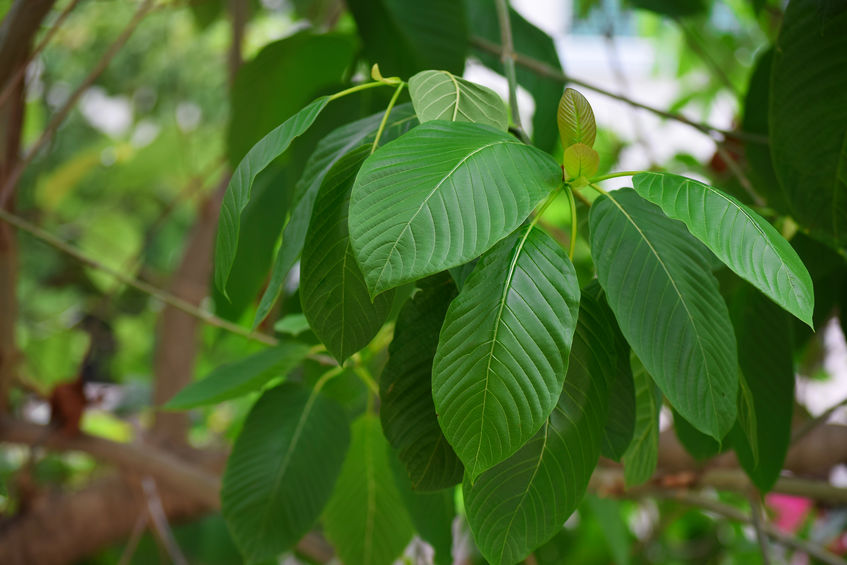Kratom - Mitragyna speciosa

Common Names: Kratom, Mitragyna, Kadamba, Puri, Biak, Biak-biak, Kutum, Ketum, Sepat, Pokok Biak, Pokok Ketum, Itchang Thom, Bai Krathom, Gratome, Giam, Mambog, Lugub, Polapupot, Kakaum, Katawn, Krathawm, Mitragyna speciosa (Latin, scientific name), Kratom leaf (English, global)
Latin Name: Mitragyna speciosa
Origin: Asia
Short Introduction
Kratom is primarily cultivated in the southern and central regions of Thailand. Generally, little is known about its cultivation. As a tropical tree, Kratom requires moist, humus-rich soil and is sensitive to frost and cold weather. The leaf harvest and processing typically take place in autumn, when the leaves are believed to be at their most potent.
Detailed Description
Kratom is a versatile plant from Southeast Asia with a range of uses.
Botanical Information
Kratom is a perennial tree that can reach up to 25 meters in height, with a trunk diameter up to 1 meter. The trunk is typically straight and upright with smooth, dark gray bark. The tree’s leaves are dark green, glossy, oval-shaped, growing opposite each other, measuring 15–20 cm long and up to 12 cm wide. Its yellow flowers grow at the ends of branches in spherical clusters, usually in groups of three. The fruit is a capsule, also forming in spherical clusters.
Origin and Distribution
Kratom originates from what are now Thailand, Indonesia, Malaysia, Myanmar, and Papua New Guinea. It was first described by Dutch botanist Pieter Korthals in 1839, and later reclassified in 1859 by George Darby Haviland. The plant still grows in the Indochina region and has spread throughout Southeast Asia, including Indonesia (Borneo and Sumatra), the Philippines, and even Vietnam. Parts and products of the plant are now recognized almost worldwide.
Usage / Dosage
Mitragyna speciosa, or Kratom, is a tropical tree native to Southeast Asia, where it is part of traditional folk medicine.
To date, there have been no clinical studies on this plant in humans, only animal and isolated tissue research. Current studies (as of 2018) have determined that data on its use are inconclusive, making it impossible to objectively define benefits, safety, and therapeutic profile. The U.S. Food and Drug Administration (FDA) has stated that there is no evidence of Kratom’s safety or efficacy for any medical indication as of February 2018.
Adverse Effects
Several national health agencies have identified Kratom as a public health risk, and some countries have banned it. Kratom is classified as a controlled substance in approximately 16 countries.
The most common and well-described adverse effects, which can occur at low doses (1–5 g of fresh leaves), include nausea, vomiting, and constipation. More severe side effects may involve respiratory depression, dependency, rapid heartbeat, increased blood pressure, psychotic behaviors, disrupted sleep, liver toxicity, and seizures. In the U.S. between 2016 and 2017, 152 deaths were attributed to Kratom overdose.
Pharmacological Effects
Kratom exhibits certain opioid-like and stimulating properties. These effects depend on both the dose and plant strain. Doses up to about 4 grams are considered stimulating, while higher doses may trigger euphoric as well as sedative effects.
Traditional Folk Medicine
In regions where Kratom grows, it is part of folk medicine. The leaves are often chewed to relieve musculoskeletal pain, increase energy, appetite, and strengthen sexual desire (in a manner similar to Khat and Coca). Leaves and decoctions may also be applied to support wound healing and for use as a local anesthetic. They are also ingested for the treatment of coughs, diarrhea, and intestinal infections.
In Thailand, Kratom is used as an intestinal antiparasitic, and laborers consume it to enhance physical strength, improve mood, and as a ‘pain reliever.’
In Malaysia, Kratom was first described in 1836 as a substitute in the treatment of opioid dependence. In Thailand, it was used for this purpose until the late 19th century. In folk medicine, Kratom is still used to manage chronic pain and address symptoms of opioid withdrawal. Some people even use it recreationally as a drug of abuse.
Active Compounds
The key active compounds in Kratom are mitragynine and 7-hydroxymitragynine. The leaves also contain about 40 other substances, including around 25 alkaloids (such as ajmalicine, mitraphylline, pseudoindoxyl mitragynine and rhynchophylline), as well as raubasine and corynantheidine.
These compounds are not currently detected by standard drug screening, but can be identified with targeted tests. Analysis in bodily fluids is carried out using liquid chromatography-tandem mass spectrometry.
Traditional Dosage
As Kratom is not officially recognized as a medicinal herb, there is no established optimal dosage. However, traditional dosage practices in folk medicine are described above in the ‘Usage’ section.
